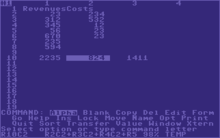Multiplan
|
Screenshots of Multiplan on DOS (top) and the Commodore 64 (bottom). | |
| Developer(s) | Doug Klunder[1] of Microsoft[1] |
|---|---|
| Initial release | 1982 |
| Development status | Unmaintained since 1985 |
| Written in | p-code C |
| Operating system | CP/M, Apple II, Macintosh, MS-DOS, Xenix, Commodore 64, CTOS, TI-99/4A, TRS-80 |
| Type | Spreadsheet |
Multiplan was an early spreadsheet program developed by Microsoft. Known initially by the code name "EP" (for "Electronic Paper"), it was introduced in 1982 as a competitor for VisiCalc.
Multiplan was released first for computers running CP/M; it was developed using a Microsoft proprietary p-code C compiler[1] as part of a portability strategy that facilitated ports to systems such as MS-DOS, Xenix, Commodore 64 and 128, Texas Instruments TI-99/4A (on four 6K GROMs and a single 8K ROM), Radio Shack TRS-80 Model II, TRS-80 Model 4, TRS-80 Model 100 (on ROM), Apple II, and Burroughs B-20 series.
Despite the release of Microsoft Chart, a graphics companion program, Multiplan continued to be outsold by Lotus 1-2-3. It was replaced by Microsoft Excel, which followed some years later on both the Apple Macintosh (1985) and Microsoft Windows (1987).
Around 1983, during the development of the first release of Windows, Microsoft had plans to make a Windows version. However the plans changed a year later.
Macintosh version
Multiplan for the Macintosh, available the month Apple released the computer, was the first third-party Macintosh software and the only spreadsheet for the Macintosh for its first year.[2] Bill Gates was repeatedly heard in 1985 saying that Microsoft made more money on Multiplan for the Macintosh than any other platform. It was proficient at making graphs and charts and was often bundled with some Macs. However, Multiplan only lasted for about a year before being overtaken by the more successful Excel.
Version compatibility
The latest version of System Software that Multiplan 1.1 was tested with is System Software 2.0 which used System 4.1 and Finder 5.5. [3]
Cell addressing differences
A fundamental difference between Multiplan and its competitors was Microsoft's decision to use R1C1 addressing instead of the A1 addressing introduced by VisiCalc. Although R1C1-style formulae are more straighforward than A1-style formulae[4] — for instance, "RC[-1]" (meaning "current row, previous column") is expressed as "A1" in cell B1, then "A2" in cell B2, etc. — most spreadsheet users prefer the A1 addressing style introduced by VisiCalc.[5][6]
Microsoft carried Multiplan's R1C1 legacy forward into Microsoft Excel, which offers both addressing modes; although A1 is MS Excel's default addressing mode.
Reception
Ahoy! called the Commodore 64 version of Multiplan, distributed by Human Engineered Software, a "professional quality spreadsheet ... There is not enough room in this article to mention all the mathematical operations performed ... Documentation is lengthy but well written".[7] A second review in the magazine noted the limitation of the computer's 40-column screen, but praised the ability to stop any ongoing action. It also praised the documentation, and concluded that "its ease of use and foolproof design make Multiplan an outstanding value".[8]
See also
References
- 1 2 3 Microsoft: The Early Days from the personal website of Richard Brodie
- ↑ Watt, Peggy; McGeever, Christine (1985-01-14). "Macintosh Vs. IBM PC At One Year". InfoWorld. pp. 16–17. Retrieved 28 December 2014.
- ↑ http://support.apple.com/kb/TA45463?viewlocale=en_US
- ↑ VBA and Macros for Microsoft Excel by Bill Jelen & Tracy Syrstad, Chapter 6
- ↑ Fundamentals of Crime Mapping: Principles and Practice by Rebecca Paynich and Bryan Hill
- ↑ Excel VBA 24-Hour Trainer by Tom Urtis
- ↑ Silveria, Terry (1984-05). "Spreadsheets for the C-64". Ahoy!. p. 18. Retrieved 27 June 2014. Check date values in:
|date=(help) - ↑ Addams, Shay (1984-06). "Multiplan". Ahoy!. pp. 55–56. Retrieved 27 June 2014. Check date values in:
|date=(help)
